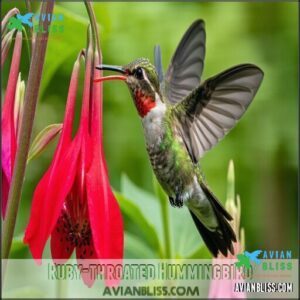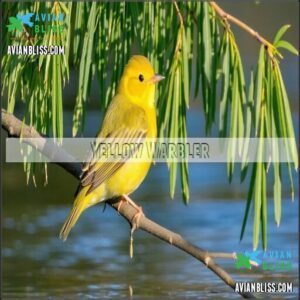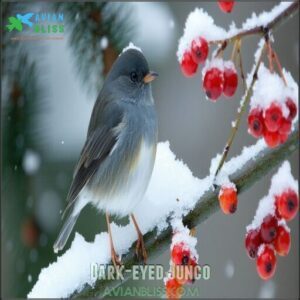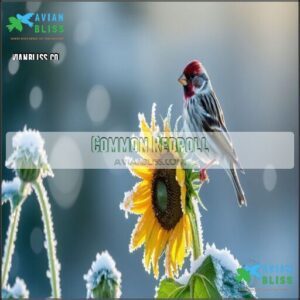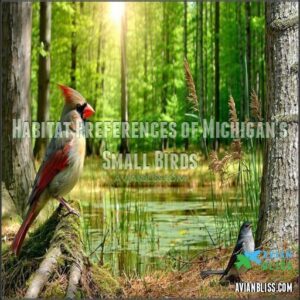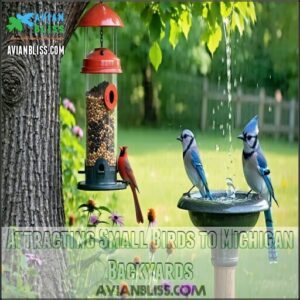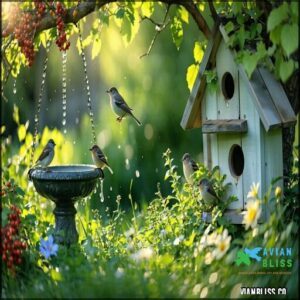This site is supported by our readers. We may earn a commission, at no cost to you, if you purchase through links.

You might also spot Tufted Titmice or tiny Downy Woodpeckers at feeders, snacking on seeds.
In summer, look for Ruby-throated Hummingbirds zipping around flowers or Yellow Warblers darting through trees.
During winter, flocks of Dark-eyed Juncos and Pine Siskins often appear.
Each bird has unique habits, from the chickadee’s cheerful calls to the goldfinch’s bright plumage.
Whether you’re a birder or just curious, Michigan’s feathered residents offer plenty to enjoy.
Stick around to learn how to attract them to your yard naturally!
Table Of Contents
- Key Takeaways
- Common Small Birds in Michigan Backyards
- Identifying Small Birds by Size and Shape
- Small Migratory Birds in Michigan
- Rare and Endangered Small Birds in Michigan
- Habitat Preferences of Michigan’s Small Birds
- Feeding Habits of Small Michigan Birds
- Nesting Behaviors of Small Michigan Birds
- Attracting Small Birds to Michigan Backyards
- Conservation Efforts for Small Michigan Birds
- Frequently Asked Questions (FAQs)
- What is the most common bird in Michigan?
- What is a small tiny bird called?
- What are the small blue-gray birds in Michigan?
- Why are unusual birds showing up in Michigan right now?
- What is the most common backyard bird?
- How do I identify a bird in my yard?
- What are the really small birds called?
- How do small birds survive Michigans harsh winters?
- Which small birds have the most unique vocalizations?
- What are the smallest bird species in Michigan?
- Conclusion
Key Takeaways
- Attract small birds to your yard by offering native plants, feeders with seeds like sunflower or nyjer, fresh water, and shelter like shrubs or evergreens.
- Learn to identify birds by size, shape, color patterns, and calls, focusing on species like chickadees, goldfinches, and nuthatches.
- Seasonal changes bring migratory visitors like Pine Siskins and Yellow Warblers, so keep an eye out for new species during migration periods.
- Conservation efforts, like habitat restoration and using native plants, help protect Michigan’s small birds from threats like habitat loss and invasive species.
Common Small Birds in Michigan Backyards
You’ll spot many colorful small birds in Michigan backyards, from the cheerful Black-capped Chickadee to the bright American Goldfinch.
These backyard visitors bring nature closer to home, offering you a chance to observe their unique behaviors and distinctive markings without leaving your property, which is a truly unique experience.
Black-capped Chickadee
The Black-capped Chickadee, a beloved Michigan backyard visitor, sports a distinctive black cap and bib with white cheeks.
The Black-capped Chickadee delights backyard bird watchers with its cheerful "chick-a-dee-dee" call and striking black-and-white markings.
These tiny survivors can lower their body temperature by 8°C on cold nights, showcasing remarkable winter survival skills.
You’ll recognize their "chick-a-dee-dee" calls, with more "dees" indicating potential threats.
Their impressive cognitive abilities allow them to remember thousands of food storage locations throughout winter, making them fascinating birds to observe at your feeders.
Tufted Titmouse
While chickadees charm with their friendliness, the Tufted Titmouse brings character to Michigan backyards with its mohawk-like crest.
This small, gray bird with large eyes is easy to spot at your feeders.
You’ll recognize its clear "peter-peter-peter" calls echoing through trees. Your backyard will become a regular stop on its daily rounds.
The Tufted Titmouse enjoys:
- Sunflower seeds as their favorite feeder food
- Insects and berries when available
- Deciduous woods as primary habitat
- Year-round residence in Michigan
White-breasted Nuthatch
While walking through Michigan’s forests, you’ll spot the compact White-breasted Nuthatch defying gravity as it creeps headfirst down tree trunks.
This small bird with distinctive white cheeks makes a nasal "yank-yank" call that echoes through deciduous habitats.
They’re easy to identify by their blue-gray backs and crisp white bellies.
Their nuthatch diet includes insects, seeds, and nuts they cleverly wedge into bark crevices for later snacking, which is a notable example of their ability to cleverly utilize their environment.
Downy Woodpecker
The tiny Downy Woodpecker is Michigan’s smallest woodpecker species, measuring just 5.5-7.1 inches in length.
You’ll easily spot this year-round resident by its:
- Striking black-and-white checkered pattern with males sporting a small red patch
- Quick, jerky movements as it climbs tree trunks
- Sharp "pik" calls and rhythmic drumming sounds
- Preference for suet, sunflower seeds and peanuts at feeders
- Tiny but powerful bill perfect for insect extraction
The key characteristics of this bird, including its size and distinctive sounds, make it a unique species to identify.
House Finch
House Finches add a splash of color to Michigan yards with their rosy-red plumage on males and streaked browns on females.
These social small birds communicate through a cheerful warbling song that peaks at dawn and dusk. You’ll hear their distinctive "weet" calls as they stay in touch with mates.
Their finch diet consists mainly of seeds, with black oil sunflower being their favorite at feeders.
Finch habitat includes city parks, backyards, and forest edges where they form noisy, gregarious groups. Look for their butterfly-like courtship flights in residential areas across Michigan.
American Goldfinch
When brilliant flashes of yellow dart around your feeder, you’re witnessing the American Goldfinch, one of Michigan’s most charming small birds.
Unlike other finches, these colorful visitors undergo complete Goldfinch Molting annually, transforming from bright summer yellow to olive-brown winter plumage.
They’ve a unique Seed Preference for Nyjer and sunflower seeds, and their Breeding Habits occur later than most Michigan bird species.
Identifying Small Birds by Size and Shape
Now that you’re familiar with Michigan’s common backyard visitors, let’s look at how to identify small birds by their physical features.
Recognizing small birds in Michigan becomes easier when you notice their size and shape. Your bird identification skills will improve by looking at:
- Relative Size – compare to familiar birds like chickadees or sparrows
- Body Shape – rounded like finches or sleek like warblers
- Tail Length – short tails on wrens or longer tails on chickadees
- Beak Shape – seed-cracking beaks versus insect-catching narrow bills
Michigan bird species often have distinctive silhouettes that help with small bird identification, even from a distance, using these identification skills to recognize them more easily with their relative size.
Small Migratory Birds in Michigan
You’ll see many small travelers in Michigan’s skies as seasonal migration brings colorful visitors like Ruby-throated Hummingbirds and Yellow Warblers to your backyard.
These birds journey hundreds of miles each year, stopping in Michigan’s diverse habitats where you can enjoy their brief but beautiful presence.
Ruby-throated Hummingbird
After looking closely, you’ll spot the Ruby-throated Hummingbird arriving in Michigan by late April.
These small birds make Michigan gardens come alive with their emerald backs and ruby throats.
- Wing power: Their wings beat 53 times per second, creating their signature hum
- Amazing journey: They cross the Gulf of Mexico in a single non-stop flight
- Hungry travelers: They visit 1,000-2,000 flowers daily
- Fuel needs: They eat half their body weight in nectar daily
Yellow Warbler
Flitting through Michigan’s tree canopies, the Yellow Warbler brings a splash of sunshine with its bright yellow plumage.
Males sport distinctive rusty-red streaks on their chests, making Yellow Warbler ID straightforward even for beginners.
These small birds prefer shrubby areas near water, where they hunt insects with quick, precise movements.
Their sweet "sweet-sweet-sweet-a-little-more-sweet" song echoes through Michigan from May to August before they begin their impressive migration to Central America.
While common during summer months, these warblers face habitat loss challenges, making conservation efforts essential for their continued presence in Michigan’s diverse bird community.
Pine Siskin
Pine Siskins travel through Michigan forests in tight-knit flocks, easily spotted by their streaked bodies and yellow-edged wings.
Their small finch size and social behavior when feeding on their preferred Nyjer and sunflower seeds are notable characteristics. Bill shapes are indicative of their diet, with slender bills hinting at insect-hunters.
The following traits make Pine Siskins a delight to observe:
- Their cheerful calls create a winter soundtrack in Michigan woodlands
- Their unpredictable migration patterns make each sighting special
- Their agile movements at feeders showcase remarkable dexterity
- Their flocking behavior provides safety from predators
- Their seasonal visits connect you to nature’s rhythms
- Their distinctive yellow wing bars brighten gray winter days
These characteristics combine to make Pine Siskins a unique and enjoyable bird to watch, with their visits offering a chance to appreciate the beauty of nature and its rhythms.
Dark-eyed Junco
Dark-eyed Juncos arrive in Michigan as winter sets in, earning their "snowbird" nickname.
You’ll spot these birds by their slate-gray backs, white bellies, and flashing white outer tail feathers when they fly.
Juncos hop rather than walk, scratching at leaf litter for seeds.
Their soft "chip" vocalizations and ground-feeding habits make them easy to identify at your winter feeders, where they gather in social flocks.
Common Redpoll
While Dark-eyed Juncos depart, Common Redpolls arrive from the Arctic.
These small finches visit Michigan during winter irruptions when food becomes scarce up north.
- Redpoll Identification: Look for the tiny red cap and black chin against their streaked, light bodies
- Winter Finch Behavior: They’ll hang upside-down at feeders, stuffing seeds into throat pouches
- Michigan Habitat: Find them at Nyjer and sunflower feeders in northern counties
Rare and Endangered Small Birds in Michigan
You’ll find several rare birds in Michigan that need special protection to survive.
These special visitors include the Kirtland’s Warbler, Piping Plover, Cerulean Warbler, and Golden-winged Warbler, each facing challenges that threaten their populations.
Kirtland’s Warbler
While exploring Michigan’s migratory birds, you’ll want to know about the remarkable Kirtland’s Warbler. This small, gray-and-yellow songbird is a true Michigan specialist, building its nests exclusively on the ground in young jack pine forests.
Once on the brink of extinction, this conservation success story was removed from the endangered species list in 2019. You can spot these birds flicking their tails as they forage for insects in northeastern Michigan.
Their recovery relies on careful habitat management and protection from brown-headed cowbird brood parasitism. Population monitoring shows these Michigan birds are making a comeback!
Piping Plover
Unlike the Kirtland’s Warbler, the Piping Plover needs beaches, not forests.
These small michigan birds have grown from just 13 pairs in 1986 to about 80 pairs by 2023.
You’ll recognize Piping Plover ID by their sandy-colored backs, white bellies, and orange legs.
Conservation status remains endangered due to habitat loss and beach development.
Both parents raise chicks in shallow sand nests, showing remarkable breeding habits despite coastal management challenges.
Cerulean Warbler
The Cerulean Warbler, with its sky-blue back and white underparts, has declined by 70% over forty years.
You’ll find these small Michigan birds high in mature deciduous forests, where males sing their buzzy trills.
Currently threatened in Michigan, they face habitat loss in both breeding grounds and wintering areas in the Andes.
Their cup-shaped nests sit 20-60 feet high, woven with bark and spiderwebs.
Conservation efforts focus on protecting large forest tracts.
Golden-winged Warbler
The Golden-winged Warbler, with its yellow crown and black throat patch, has become one of Michigan’s most threatened small birds.
Once common in shrubby habitats, its population has declined by two-thirds since 1970.
- Hybridization effects with Blue-winged Warblers create identification challenges
- Habitat loss threatens their breeding grounds in the Great Lakes region
- Conservation status is Near Threatened, with groups working to protect remaining populations
You’ll find them in wet thickets during migration.
Habitat Preferences of Michigan’s Small Birds
You’ll find Michigan’s small birds making their homes in four main habitat types, from chickadees in deciduous forests to juncos in coniferous woodlands.
Each species has adapted to specific environments where they can find their preferred food, shelter, and nesting sites.
Coniferous Forest Species
Michigan’s coniferous forests host specialized small birds.
You’ll find Red-breasted Nuthatches detecting spruce budworm increases as nature’s pest control.
Pine Siskins nest in loose colonies among evergreens.
| Species | Habitat | Behavior |
|---|---|---|
| Blackcapped Chickadee | Mixed forests | Food storage |
| Red Crossbill | Jack/red/white pine | Specialized beak |
| Pine Siskin | Evergreen forests | Winter foraging |
| Spruce Grouse | Black spruce/jack pine | Ground dwelling |
Forest management affects these Michigan bird species where habitat fragmentation threatens their survival.
Some species, like the Downy Woodpecker identification, relies on these forests for survival.
The specialized nature of these birds and their dependence on specific habitats make conservation efforts crucial.
Deciduous Forest Species
While coniferous forests host unique bird species, deciduous woodlands offer different small birds their perfect home.
In Michigan’s leafy forests, you’ll find:
- White-breasted nuthatches climbing tree trunks headfirst, searching bark crevices for insects
- Red-eyed vireos singing persistently from the canopy all summer long
- Black-throated green warblers flitting through branches catching caterpillars
- American goldfinches bouncing through forest edges seeking seeds
These birds thrive where hardwoods like maple, birch, and oak trees dominate.
Wetland and Riparian Species
Let me improve this content for the wetland and riparian species section.
Five small wetland birds thrive along Michigan’s water edges.
You’ll spot red-winged blackbirds with their distinctive shoulder patches in cattail marshes.
Swamp sparrows hide in dense vegetation, their rusty caps barely visible.
| Species | Marsh Habitats | Riparian Diet | Conservation Status |
|---|---|---|---|
| Sandhill Crane | Large wetlands | Plants, small animals | Stable |
| Yellow Warbler | Shrubby wetlands | Insects | Common |
| Great Blue Heron | Rivers, swamps | Fish | Stable |
| Red-winged Blackbird | Cattail marshes | Seeds, insects | Abundant |
During waterbird migration, these wetland nesting areas become essential stopover points.
Michigan’s wetlands support these small birds year-round.
Grassland and Prairie Species
While wetlands host water-loving species, Michigan’s grasslands and prairies support their own unique small birds.
Eastern meadowlarks and savannah sparrows commonly share these open spaces, while the declining bobolinks can still be spotted in places like Maple River State Game Area.
Look for uncommon grassland visitors like upland sandpipers, grasshopper sparrows, and northern harriers.
The rare Henslow’s sparrow, facing significant population declines, represents the conservation challenges these prairie bird species face.
Feeding Habits of Small Michigan Birds
You’ll notice Michigan’s small birds have specific food preferences that help them survive throughout the changing seasons.
From goldfinches that love nyjer seeds to chickadees that enthusiastically grab sunflower seeds from your palm, understanding these dietary habits helps you attract more colorful visitors to your yard.
Seed-eaters
Seed-eating small birds in Michigan have specialized beaks for cracking open tough shells.
American Goldfinches, House Finches, and Pine Siskins flock to feeders filled with their favorites – sunflower, nyjer, and millet seeds.
You’ll notice these birds have different seed preferences throughout the year, with winter feeding becoming essential for survival.
Fill various feeder types to support their nutritional needs, and you might observe fascinating seed dispersal behaviors as they cache food for later.
Insectivores
If you’ve spotted Michigan’s small birds snapping up bugs, you’re likely watching insectivores in action.
These feathered hunters rely on a sharp insect diet, targeting mosquitoes, moths, and more.
Known for their active foraging techniques, they’re nature’s pest control, helping keep the bug population in check.
Species like chickadees and warblers masterfully hunt mid-air, showcasing incredible skill.
Unfortunately, pesticide effects threaten their food supply, so supporting these insect-loving birds benefits both your garden and their survival.
Nectar-feeders
The ruby-throated hummingbird, a favorite among Michigan’s small birds, thrives on nectar and makes a charming guest.
With emerald backs and ruby throats, ruby-throated hummingbirds bring life to Michigan gardens, dazzling with every sip of nectar.
Here’s how to keep them buzzing:
- Use the right mix: Combine 1 part sugar with 4 parts water—skip dyes.
- Provide nectar sources: Plant bee balm or salvia.
- Place feeders wisely: Shade keeps nectar fresh.
- Prioritize feeder maintenance: Clean daily to avoid mold.
Omnivores
Omnivores in Michigan’s bird world are nature’s adaptable feeders.
Backyard omnivores like Downy Woodpeckers and chickadees balance their bird diet with insects, seeds, and berries.
Seasonal changes steer their feeding strategies—snacking on protein-rich caterpillars in summer, then switching to suet and sunflower seeds in winter.
These small birds meet their nutritional needs by embracing variety, making Michigan’s bird species diet fascinating to observe year-round.
Mindful observation can help birdwatchers understand their feeding behavior patterns, and appreciate the adaptability of these birds in different seasons, showcasing their unique characteristics.
Nesting Behaviors of Small Michigan Birds
You’ll be amazed at how small Michigan birds build safe, clever nests in the most unexpected places.
From cavities in trees to open cups in shrubs, each species has its own unique way of raising their young, with complete concepts of nesting that are fascinating to observe.
Cavity Nesters
Cavity nesters, like Michigan’s Downy Woodpecker and House Wren, thrive in tree hollows and bird houses.
These backyard birds use precise excavation techniques or adapt existing spaces. Competition for these cavities is fierce, and clever tricks, like storing seeds near nests, fend off intruders.
- Cavity Size: Varies based on species.
- Nest Materials: Soft fibers, moss, or bark.
- Clutch Size: 3–8 eggs.
- Predator Avoidance: Hidden entryways offer safety.
Open-cup Nesters
Birds that create open-cup nests bring elegance and purpose to Michigan backyards.
These nests, woven with twigs, moss, and grasses, are hidden in leafy branches for safety.
They’re delicate yet strong, blending beautifully with their surroundings to keep predators guessing.
Each design reflects parental care and the goal of fledgling success.
Nest building signals a bird’s fitness and resourcefulness.
- Carefully select twigs and soft materials for nest construction.
- Position nests in high, sheltered spots within bird habitats.
- Eggs are often camouflaged to match the nest’s environment.
- Nests offer warmth and protection for backyard birds and their chicks.
Ground Nesters
Hidden in Michigan’s bird habitats, ground nesters like ovenbirds and killdeer use clever camouflage techniques to protect their eggs from nest predators.
Their clutch size varies, blending with forest floors, grasslands, and rocky edges.
Vesper sparrows craft nests with grass and twigs, while eastern towhees tuck into low nests in shrubs. These small birds adapt perfectly to diverse ground nesting habitats, ensuring survival.
Nest Box Preferences
Finding the right nest box for small birds in Michigan can feel like matchmaking. Each species, like the House Wren, has specific nesting needs.
You’ll need to get these four basics right for success:
- Box Size: Keep dimensions around 4"x4" to 5"x5" for species like chickadees and bluebirds.
- Entry Hole: Precision matters! Use a 1 1/2" hole for bluebirds to keep predators out.
- Material Choice: Weather-resistant wood works best; avoid treated lumber.
- Mounting Height: Fit the bird’s comfort zone—5-10 feet from the ground is usually ideal.
Well-placed boxes in open spaces boost bird attraction and nesting. You can find a Michigan bluebird house online.
Attracting Small Birds to Michigan Backyards
You can attract small birds to your Michigan backyard by offering native plants, fresh water, shelter, and the right feeders.
Providing a mix of seeds, suet, and natural spaces will help create a bird-friendly habitat.
Native Plant Selection
Plant native species to create a haven for small birds in Michigan ecosystems.
Berry bushes like serviceberry offer essential food, while seed sources such as black-eyed susans fuel birds through winter.
Wildflowers like bergamot attract insects, providing protein-rich meals for busy feathered visitors. Include drought-tolerant plants to guarantee consistent resources.
Consider Michigan native plant options for superior results. Native plants also offer nesting materials and insect habitats, supporting bird attraction year-round.
By mimicking natural habitats, you’ll create a thriving backyard refuge for Michigan’s birds.
Types of Bird Feeders
Feeders are like dinner tables for small birds in Michigan, catering to their diverse diets.
Picking the right type will bring life to your yard:
- Hopper Feeders: Versatile and great for mixed seed blends.
- Tube Feeders: Perfect for finches and siskins who love sunflower seeds.
- Platform Feeders: Open spaces attract chickadees, titmice, and sparrows.
- Suet Feeders: Protein-rich snacks for nuthatches and woodpeckers.
Consider various feeder options for attracting more birds.
Follow these bird feeding tips, and you’ll create a feast for feathered visitors!
Water Sources
Water availability can attract incredible small birds in Michigan to your yard.
Beyond bird feeders, offering fresh, clean water makes a real difference. Bird baths are a favorite choice—ensure they’re shallow and easy to access.
Drip fountains and misting stations also draw birds by mimicking natural sources, while shallow ponds provide a more expansive option for hydration and play.
Winter water matters too; consider heated baths so feathered friends don’t search elsewhere.
Always prioritize cleanliness—scrub bird baths weekly to prevent algae or bacteria. Providing reliable water turns your yard into a bird watcher’s paradise!
Creating Shelter and Cover
Make your backyard irresistible to small birds by creating safe, cozy habitats.
Try these ideas:
- Add brush piles for hiding spots and predator protection.
- Plant native shrubs, offering shelter and nesting areas.
- Install roosting boxes to house Michigan’s feathered friends.
- Use evergreens as winter cover, keeping birds warm during frigid months.
These thoughtful changes support bird conservation and biodiversity.
Conservation Efforts for Small Michigan Birds
You can help protect Michigan’s small birds by supporting conservation efforts that restore habitats and manage invasive species.
These actions, combined with bird-friendly practices and citizen science programs, guarantee their survival for future generations.
Habitat Restoration Projects
Michigan’s bird habitat restoration projects reclaim forests and wetlands, creating safe spaces for small birds.
Wetland restoration supports waterbirds, while forest management brings back songbird-friendly cover.
Conservation easements and native plants enhance backyard habitats, connecting ecosystems.
These efforts protect biodiversity and guarantee habitats thrive for generations, giving Michigan’s small birds a chance to flourish in their natural environments.
Protecting these areas involves community engagement strategies to guarantee their long-term value.
Citizen Science Programs
Citizen science programs let you enjoy bird watching while making a difference for Michigan’s small birds.
Get involved with Project FeederWatch, where your data collection supports bird species research, or try NestWatch to track nesting successes.
Through volunteer training and simple tools, you’ll assist with bird monitoring and understand the habitat impact of conservation action—perfect for bird lovers keen to help!
Bird-friendly Building Practices
Protect small birds in Michigan by designing bird-friendly spaces.
Glass collisions and light pollution harm Michigan bird habitats, but thoughtful choices make a big difference:
- Use bird-safe glass with UV patterns.
- Limit nighttime lights to reduce disorientation.
- Add green roofs for nesting structures.
- Choose sustainable materials supporting bird habitat conservation.
Turn your building into a safe haven for small birds.
Invasive Species Management
Invasive species impact Michigan bird conservation by disrupting bird habitats and native ecosystems.
To help, try these prevention strategies at home:
| Action | Impact | Control Methods |
|---|---|---|
| Remove Garlic Mustard | Restores native plants | Hand-pull or use herbicide |
| Manage House Sparrows | Reduces nest competition | Monitor and control populations |
| Limit Common Starlings | Protects cavity-nesting birds | Use nest box strategies |
| Eliminate Feral Cats | Saves ground-nesting species | Support TNR programs |
| Protect Native Plants | Enhances Michigan bird habitats | Landscape with native species |
With small steps, you can safeguard Michigan wildlife and increase public awareness of the importance of preserving native ecosystems to support bird conservation.
Frequently Asked Questions (FAQs)
What is the most common bird in Michigan?
It’s no surprise that the American Goldfinch is Michigan’s most common bird.
Its cheerful yellow feathers and sweet songs brighten backyards year-round, especially near sunflower and Nyjer seed feeders, making it a favorite for birdwatchers.
What is a small tiny bird called?
A small, tiny bird is often called a wren, finch, or chickadee.
These tiny creatures dazzle with their quick movements, soft calls, and petite size, often fitting perfectly in the palm of your hand!
What are the small blue-gray birds in Michigan?
About 15% of Michigan’s birds are small and blue-gray, like the Tufted Titmouse or White-breasted Nuthatch.
You’ll spot them in forests or backyards, snacking on sunflower seeds, exploring trees, and calling out charmingly.
Why are unusual birds showing up in Michigan right now?
You’re likely noticing unusual birds in Michigan because migration season is underway.
Climate changes and shifting weather patterns can also bring rare species into new areas as they search for food, shelter, or breeding grounds, influenced by climate changes.
What is the most common backyard bird?
The Black-capped Chickadee is the most common backyard bird.
Its cheerful calls and bold personality make it a favorite.
You’ll spot them year-round, often visiting feeders for sunflower seeds and blending effortlessly into wooded areas.
How do I identify a bird in my yard?
Start by noting size, colors, and patterns.
Watch its behavior, like how it moves or feeds. Listen for unique calls.
Grab binoculars and a field guide, or use a bird-identification app for help!
What are the really small birds called?
The really small birds you might see are chickadees, goldfinches, wrens, or sparrows.
They’re lightweight, quick, and often found at feeders or trees.
Look for bright colors, soft songs, or tiny, lively movements!
How do small birds survive Michigans harsh winters?
Small birds survive Michigan’s winters by fluffing their feathers to trap heat, huddling together for warmth, storing fat for energy, and seeking food at feeders.
Some even lower body temperatures to conserve energy during frigid nights.
Which small birds have the most unique vocalizations?
Imagine a song that tells a story.
The Song Sparrow’s melodies vary by bird, while the White-throated Sparrow whistles sweetly.
Northern Mockingbirds amaze with mimicry, and Chickadees charm you with their cheerful “dee-dee-dee!” that showcases their unique melodies.
What are the smallest bird species in Michigan?
The smallest birds in Michigan include the Downy Woodpecker, House Wren, American Goldfinch, and Black-capped Chickadee.
These petite species weigh under an ounce, showcasing vibrant colors, diverse songs, and fascinating behaviors in forests and backyards alike.
Conclusion
You don’t need to be an expert to enjoy the small birds in Michigan.
Setting up feeders with seeds or planting native flowers can bring birds like Black-capped Chickadees or Ruby-throated Hummingbirds to your yard.
Providing water and shelter makes a big difference too.
Don’t forget to look for migratory visitors like Pine Siskins or Yellow Warblers during seasonal changes.
With a bit of effort, you’ll create a haven for these charming feathered friends.
- https://thumbwind.com/2021/08/15/river-road-scenic-byway/
- https://seas.umich.edu/news/long-term-habitat-restoration-and-community-engagement-michigan-audubon-bird-sanctuary
- https://naturenearby.org/building-a-forest-for-birds-at-wege-foundation-natural-area/
- https://www.peopleforpalmerpark.org/habitat-project.html
- https://www.fisheries.noaa.gov/national/habitat-conservation/current-and-past-great-lakes-habitat-restoration-projects


